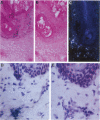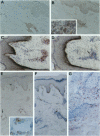Abstract
The pattern of cytokine production of skin-infiltrating T cells from patients with progressive systemic sclerosis was investigated. Most CD4+ T-cell clones generated from skin biopsy specimens showed a type 2 helper (Th2) cytokine profile (production of interleukin-4, but no interferon (IFN)-gamma). High interleukin-4 but little or no IFN-gamma mRNA expression was found by in situ hybridization in skin perivascular mononuclear cell infiltrates. The immunohistochemical analysis revealed CD30 expression by high numbers of CD4+ T cells in the same specimens. Finally, the great majority of patients with diffuse disease had elevated levels of soluble CD30 in their sera. These data suggest the existence in patients with progressive systemic sclerosis of a predominant activation of Th2-like T cells, which may account for the major alterations (endothelial cell injury, fibrosis, and autoantibody production) occurring in this disease.
Full text
PDF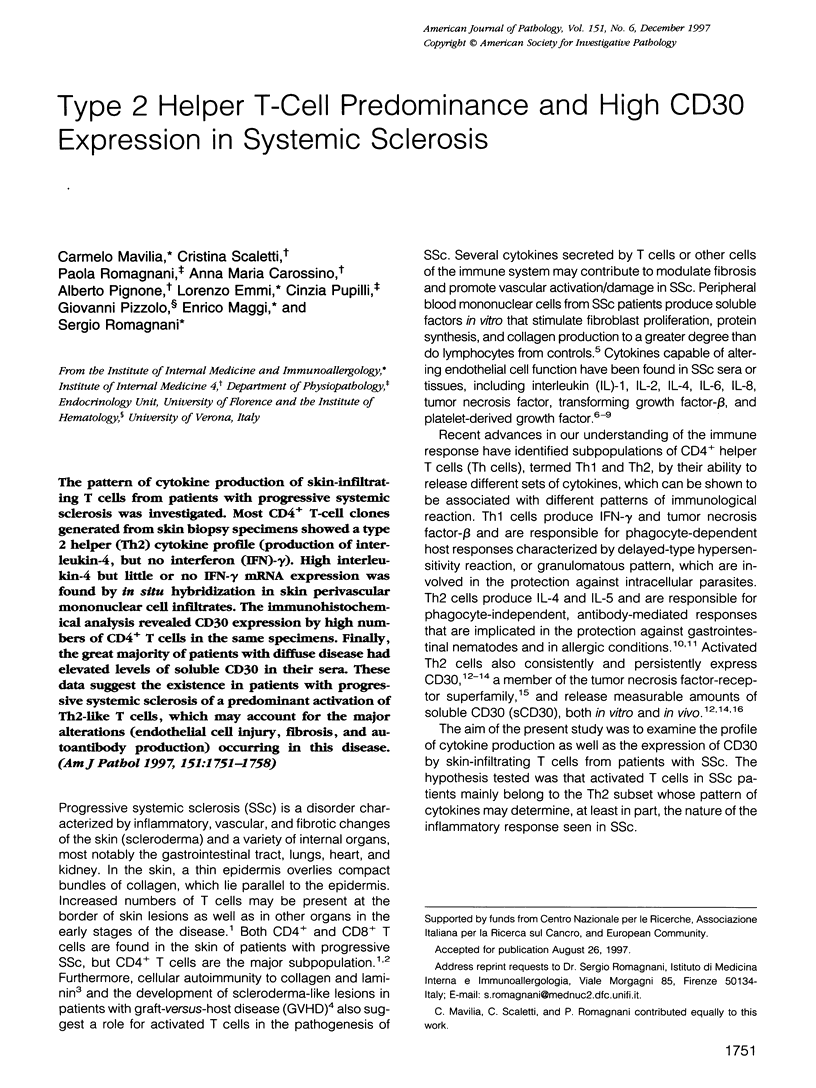
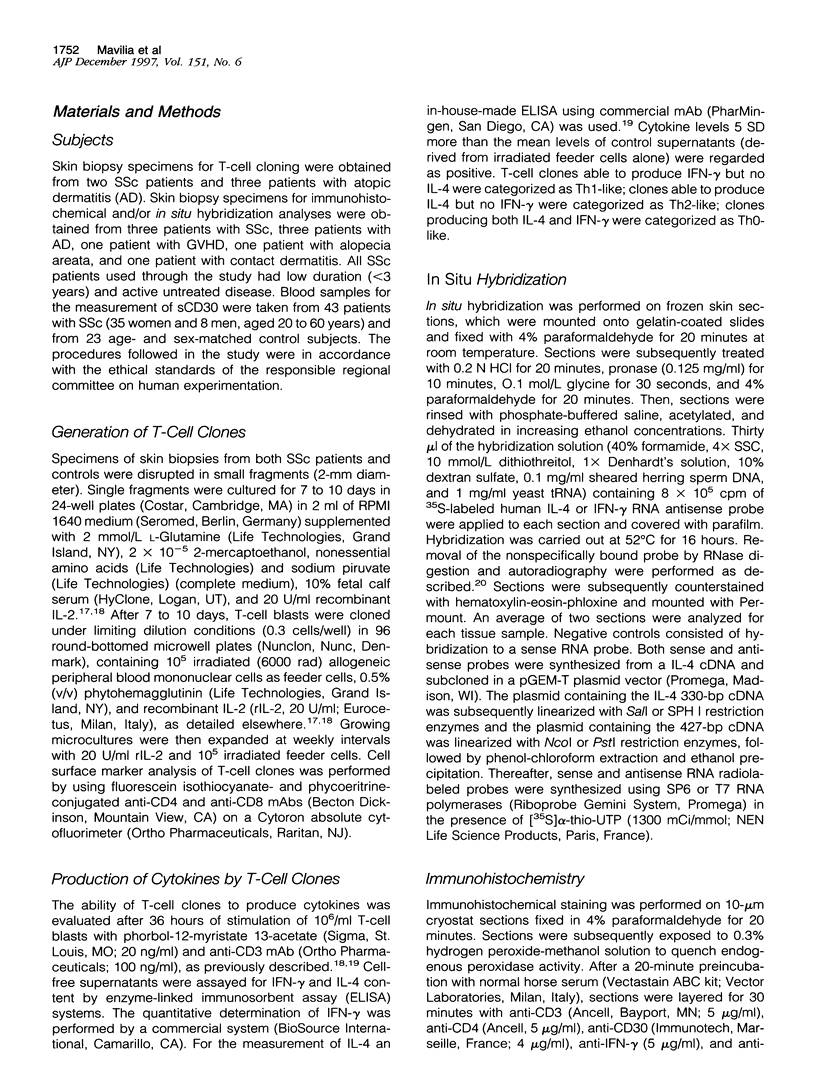
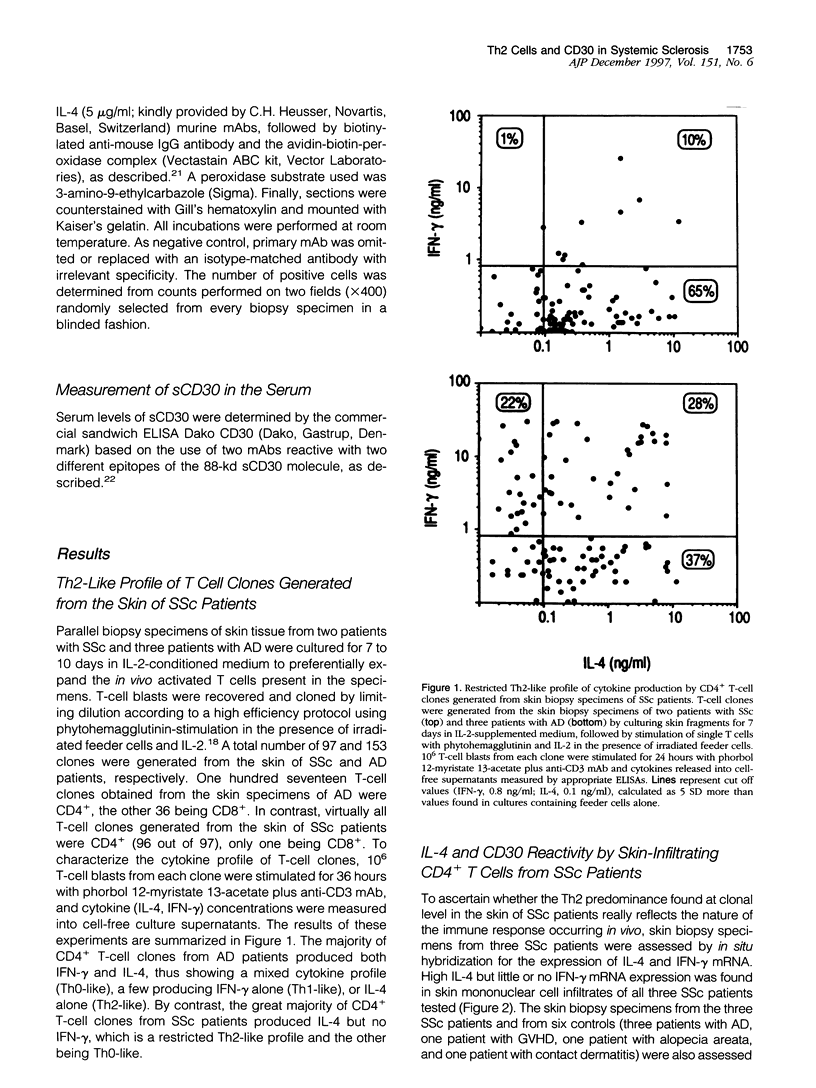
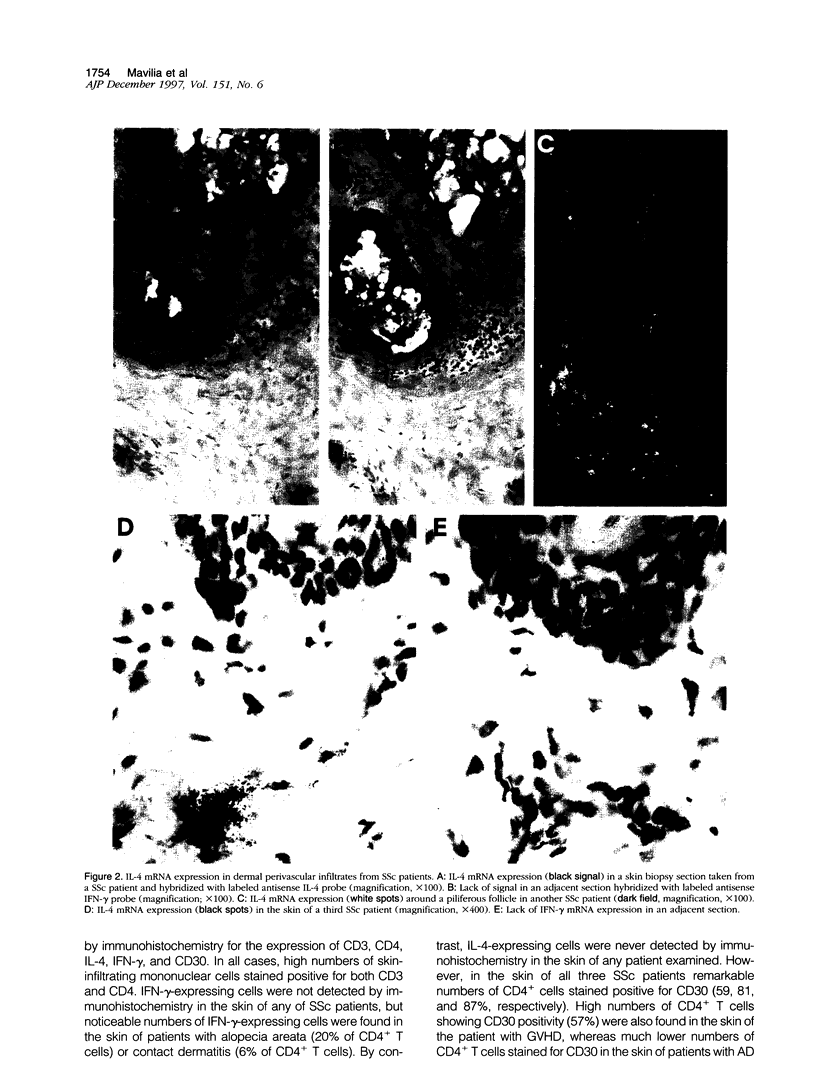
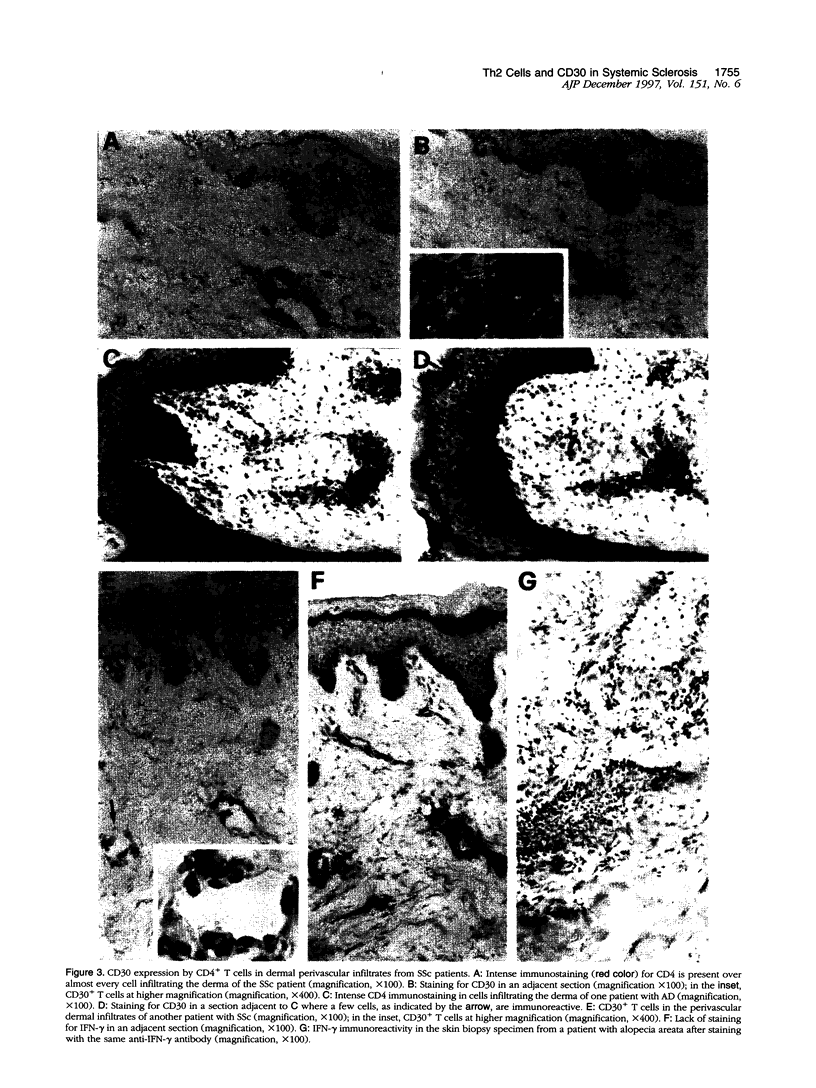
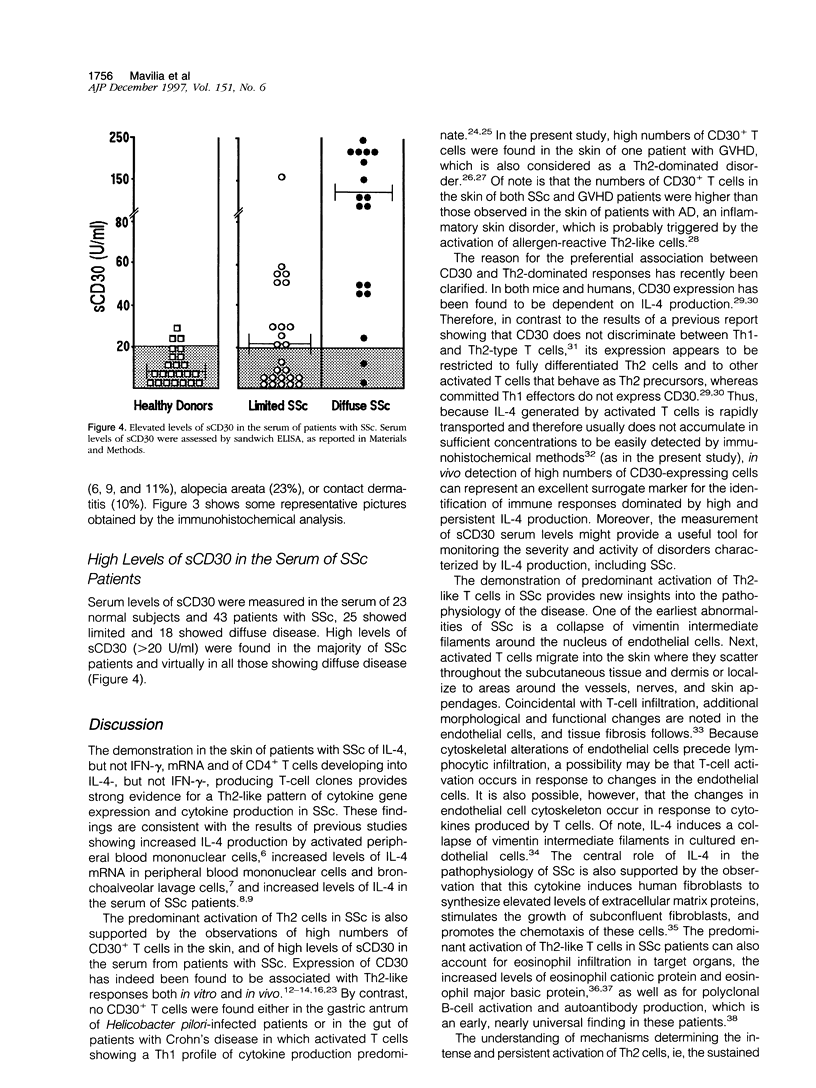
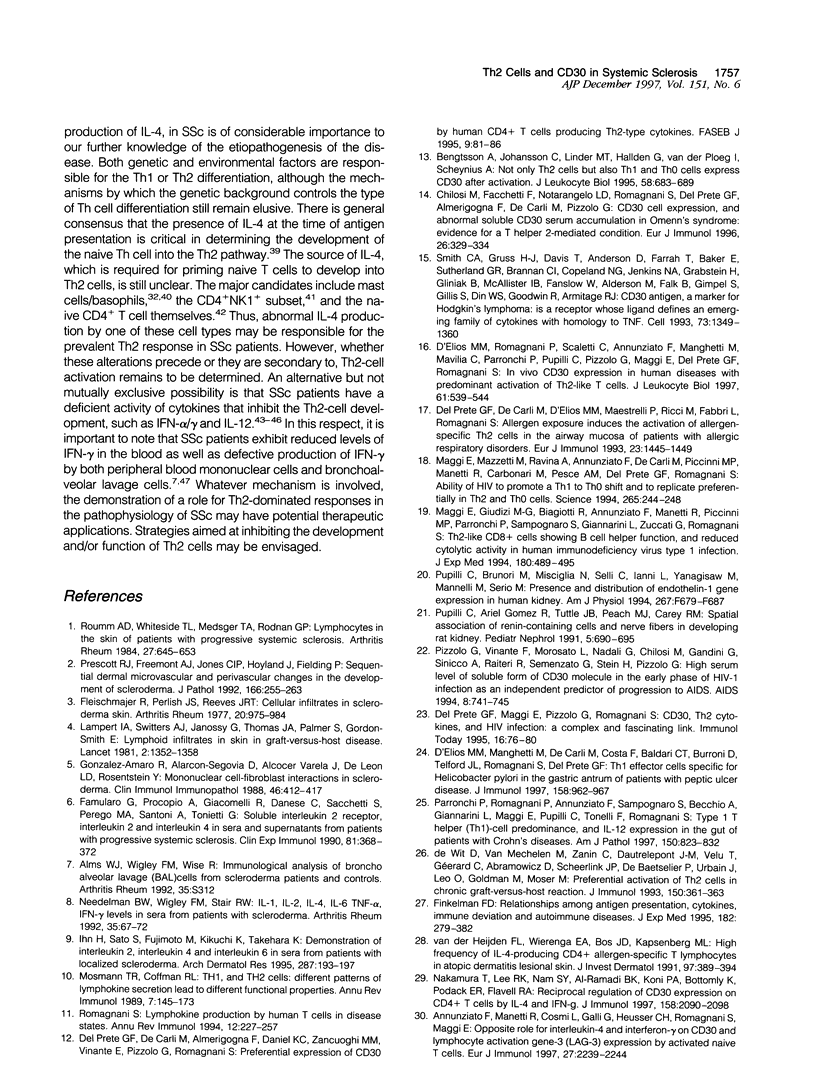
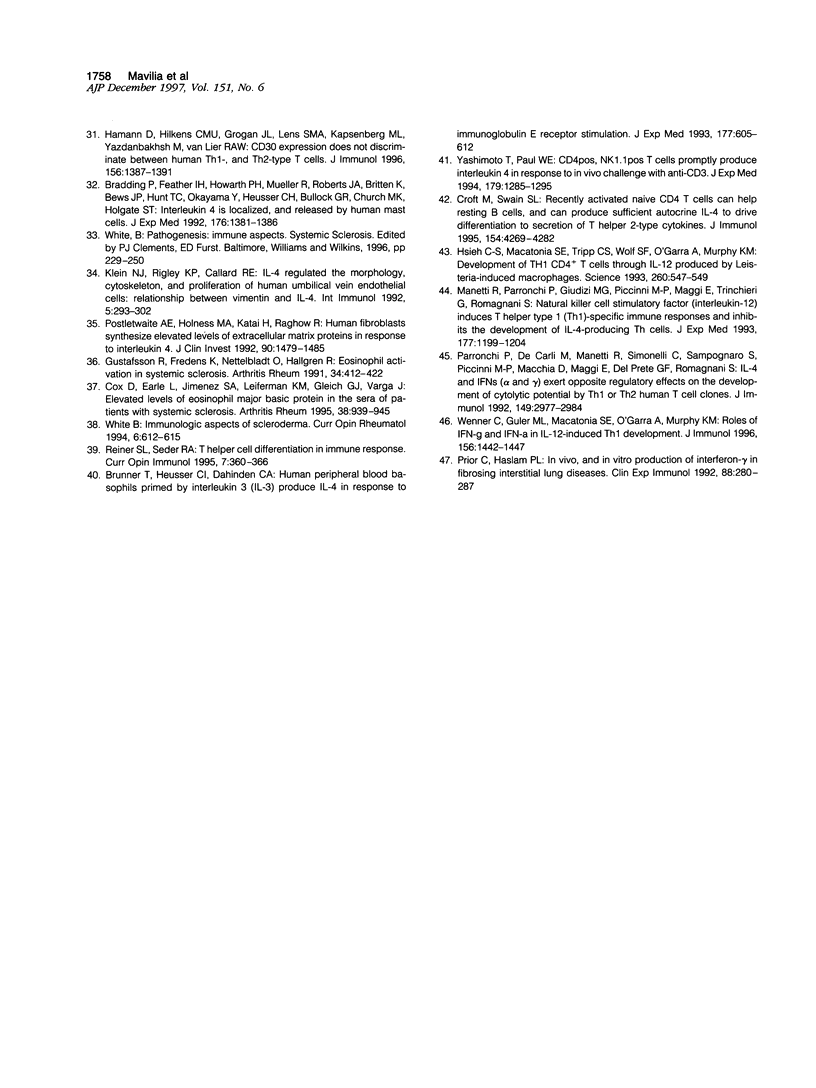
Images in this article
Selected References
These references are in PubMed. This may not be the complete list of references from this article.
- Annunziato F., Manetti R., Cosmi L., Galli G., Heusser C. H., Romagnani S., Maggi E. Opposite role for interleukin-4 and interferon-gamma on CD30 and lymphocyte activation gene-3 (LAG-3) expression by activated naive T cells. Eur J Immunol. 1997 Sep;27(9):2239–2244. doi: 10.1002/eji.1830270918. [DOI] [PubMed] [Google Scholar]
- Bengtsson A., Johansson C., Linder M. T., Halldén G., van der Ploeg I., Scheynius A. Not only Th2 cells but also Th1 and Th0 cells express CD30 after activation. J Leukoc Biol. 1995 Dec;58(6):683–689. doi: 10.1002/jlb.58.6.683. [DOI] [PubMed] [Google Scholar]
- Bradding P., Feather I. H., Howarth P. H., Mueller R., Roberts J. A., Britten K., Bews J. P., Hunt T. C., Okayama Y., Heusser C. H. Interleukin 4 is localized to and released by human mast cells. J Exp Med. 1992 Nov 1;176(5):1381–1386. doi: 10.1084/jem.176.5.1381. [DOI] [PMC free article] [PubMed] [Google Scholar]
- Brunner T., Heusser C. H., Dahinden C. A. Human peripheral blood basophils primed by interleukin 3 (IL-3) produce IL-4 in response to immunoglobulin E receptor stimulation. J Exp Med. 1993 Mar 1;177(3):605–611. doi: 10.1084/jem.177.3.605. [DOI] [PMC free article] [PubMed] [Google Scholar]
- Chilosi M., Facchetti F., Notarangelo L. D., Romagnani S., Del Prete G., Almerigogna F., De Carli M., Pizzolo G. CD30 cell expression and abnormal soluble CD30 serum accumulation in Omenn's syndrome: evidence for a T helper 2-mediated condition. Eur J Immunol. 1996 Feb;26(2):329–334. doi: 10.1002/eji.1830260209. [DOI] [PubMed] [Google Scholar]
- Cox D., Earle L., Jimenez S. A., Leiferman K. M., Gleich G. J., Varga J. Elevated levels of eosinophil major basic protein in the sera of patients with systemic sclerosis. Arthritis Rheum. 1995 Jul;38(7):939–945. doi: 10.1002/art.1780380709. [DOI] [PubMed] [Google Scholar]
- Croft M., Swain S. L. Recently activated naive CD4 T cells can help resting B cells, and can produce sufficient autocrine IL-4 to drive differentiation to secretion of T helper 2-type cytokines. J Immunol. 1995 May 1;154(9):4269–4282. [PubMed] [Google Scholar]
- D'Elios M. M., Manghetti M., De Carli M., Costa F., Baldari C. T., Burroni D., Telford J. L., Romagnani S., Del Prete G. T helper 1 effector cells specific for Helicobacter pylori in the gastric antrum of patients with peptic ulcer disease. J Immunol. 1997 Jan 15;158(2):962–967. [PubMed] [Google Scholar]
- D'Elios M. M., Romagnani P., Scaletti C., Annunziato F., Manghetti M., Mavilia C., Parronchi P., Pupilli C., Pizzolo G., Maggi E. In vivo CD30 expression in human diseases with predominant activation of Th2-like T cells. J Leukoc Biol. 1997 May;61(5):539–544. [PubMed] [Google Scholar]
- De Wit D., Van Mechelen M., Zanin C., Doutrelepont J. M., Velu T., Gérard C., Abramowicz D., Scheerlinck J. P., De Baetselier P., Urbain J. Preferential activation of Th2 cells in chronic graft-versus-host reaction. J Immunol. 1993 Jan 15;150(2):361–366. [PubMed] [Google Scholar]
- Del Prete G. F., De Carli M., D'Elios M. M., Maestrelli P., Ricci M., Fabbri L., Romagnani S. Allergen exposure induces the activation of allergen-specific Th2 cells in the airway mucosa of patients with allergic respiratory disorders. Eur J Immunol. 1993 Jul;23(7):1445–1449. doi: 10.1002/eji.1830230707. [DOI] [PubMed] [Google Scholar]
- Del Prete G., De Carli M., Almerigogna F., Daniel C. K., D'Elios M. M., Zancuoghi G., Vinante F., Pizzolo G., Romagnani S. Preferential expression of CD30 by human CD4+ T cells producing Th2-type cytokines. FASEB J. 1995 Jan;9(1):81–86. [PubMed] [Google Scholar]
- Del Prete G., Maggi E., Pizzolo G., Romagnani S. CD30, Th2 cytokines and HIV infection: a complex and fascinating link. Immunol Today. 1995 Feb;16(2):76–80. doi: 10.1016/0167-5699(95)80092-1. [DOI] [PubMed] [Google Scholar]
- Famularo G., Procopio A., Giacomelli R., Danese C., Sacchetti S., Perego M. A., Santoni A., Tonietti G. Soluble interleukin-2 receptor, interleukin-2 and interleukin-4 in sera and supernatants from patients with progressive systemic sclerosis. Clin Exp Immunol. 1990 Sep;81(3):368–372. doi: 10.1111/j.1365-2249.1990.tb05340.x. [DOI] [PMC free article] [PubMed] [Google Scholar]
- Finkelman F. D. Relationships among antigen presentation, cytokines, immune deviation, and autoimmune disease. J Exp Med. 1995 Aug 1;182(2):279–282. doi: 10.1084/jem.182.2.279. [DOI] [PMC free article] [PubMed] [Google Scholar]
- Fleischmajer R., Perlish J. S., Reeves J. R. Cellular infiltrates in scleroderma skin. Arthritis Rheum. 1977 May;20(4):975–984. doi: 10.1002/art.1780200410. [DOI] [PubMed] [Google Scholar]
- Gonzalez-Amaro R., Alarcon-Segovia D., Alcocer-Varela J., Diaz de Leon L., Rosenstein Y. Mononuclear cell-fibroblast interactions in scleroderma. Clin Immunol Immunopathol. 1988 Mar;46(3):412–420. doi: 10.1016/0090-1229(88)90060-8. [DOI] [PubMed] [Google Scholar]
- Gustafsson R., Fredens K., Nettelbladt O., Hällgren R. Eosinophil activation in systemic sclerosis. Arthritis Rheum. 1991 Apr;34(4):414–422. doi: 10.1002/art.1780340406. [DOI] [PubMed] [Google Scholar]
- Hamann D., Hilkens C. M., Grogan J. L., Lens S. M., Kapsenberg M. L., Yazdanbakhsh M., van Lier R. A. CD30 expression does not discriminate between human Th1- and Th2-type T cells. J Immunol. 1996 Feb 15;156(4):1387–1391. [PubMed] [Google Scholar]
- Hsieh C. S., Macatonia S. E., Tripp C. S., Wolf S. F., O'Garra A., Murphy K. M. Development of TH1 CD4+ T cells through IL-12 produced by Listeria-induced macrophages. Science. 1993 Apr 23;260(5107):547–549. doi: 10.1126/science.8097338. [DOI] [PubMed] [Google Scholar]
- Ihn H., Sato S., Fujimoto M., Kikuchi K., Takehara K. Demonstration of interleukin-2, interleukin-4 and interleukin-6 in sera from patients with localized scleroderma. Arch Dermatol Res. 1995;287(2):193–197. doi: 10.1007/BF01262331. [DOI] [PubMed] [Google Scholar]
- Klein N. J., Rigley K. P., Callard R. E. IL-4 regulates the morphology, cytoskeleton, and proliferation of human umbilical vein endothelial cells: relationship between vimentin and CD23. Int Immunol. 1993 Mar;5(3):293–301. doi: 10.1093/intimm/5.3.293. [DOI] [PubMed] [Google Scholar]
- Lambert I. A., Suitters A. J., Janossy G., Thomas J. A., Palmer S., Gordon Smith E. Lymphoid infiltrates in skin in graft-versus-host disease. Lancet. 1981 Dec 12;2(8259):1352–1352. doi: 10.1016/s0140-6736(81)91378-7. [DOI] [PubMed] [Google Scholar]
- Maggi E., Giudizi M. G., Biagiotti R., Annunziato F., Manetti R., Piccinni M. P., Parronchi P., Sampognaro S., Giannarini L., Zuccati G. Th2-like CD8+ T cells showing B cell helper function and reduced cytolytic activity in human immunodeficiency virus type 1 infection. J Exp Med. 1994 Aug 1;180(2):489–495. doi: 10.1084/jem.180.2.489. [DOI] [PMC free article] [PubMed] [Google Scholar]
- Maggi E., Mazzetti M., Ravina A., Annunziato F., de Carli M., Piccinni M. P., Manetti R., Carbonari M., Pesce A. M., del Prete G. Ability of HIV to promote a TH1 to TH0 shift and to replicate preferentially in TH2 and TH0 cells. Science. 1994 Jul 8;265(5169):244–248. doi: 10.1126/science.8023142. [DOI] [PubMed] [Google Scholar]
- Manetti R., Parronchi P., Giudizi M. G., Piccinni M. P., Maggi E., Trinchieri G., Romagnani S. Natural killer cell stimulatory factor (interleukin 12 [IL-12]) induces T helper type 1 (Th1)-specific immune responses and inhibits the development of IL-4-producing Th cells. J Exp Med. 1993 Apr 1;177(4):1199–1204. doi: 10.1084/jem.177.4.1199. [DOI] [PMC free article] [PubMed] [Google Scholar]
- Mosmann T. R., Coffman R. L. TH1 and TH2 cells: different patterns of lymphokine secretion lead to different functional properties. Annu Rev Immunol. 1989;7:145–173. doi: 10.1146/annurev.iy.07.040189.001045. [DOI] [PubMed] [Google Scholar]
- Nakamura T., Lee R. K., Nam S. Y., Al-Ramadi B. K., Koni P. A., Bottomly K., Podack E. R., Flavell R. A. Reciprocal regulation of CD30 expression on CD4+ T cells by IL-4 and IFN-gamma. J Immunol. 1997 Mar 1;158(5):2090–2098. [PubMed] [Google Scholar]
- Needleman B. W., Wigley F. M., Stair R. W. Interleukin-1, interleukin-2, interleukin-4, interleukin-6, tumor necrosis factor alpha, and interferon-gamma levels in sera from patients with scleroderma. Arthritis Rheum. 1992 Jan;35(1):67–72. doi: 10.1002/art.1780350111. [DOI] [PubMed] [Google Scholar]
- Parronchi P., De Carli M., Manetti R., Simonelli C., Sampognaro S., Piccinni M. P., Macchia D., Maggi E., Del Prete G., Romagnani S. IL-4 and IFN (alpha and gamma) exert opposite regulatory effects on the development of cytolytic potential by Th1 or Th2 human T cell clones. J Immunol. 1992 Nov 1;149(9):2977–2983. [PubMed] [Google Scholar]
- Parronchi P., Romagnani P., Annunziato F., Sampognaro S., Becchio A., Giannarini L., Maggi E., Pupilli C., Tonelli F., Romagnani S. Type 1 T-helper cell predominance and interleukin-12 expression in the gut of patients with Crohn's disease. Am J Pathol. 1997 Mar;150(3):823–832. [PMC free article] [PubMed] [Google Scholar]
- Pizzolo G., Vinante F., Morosato L., Nadali G., Chilosi M., Gandini G., Sinicco A., Raiteri R., Semenzato G., Stein H. High serum level of the soluble form of CD30 molecule in the early phase of HIV-1 infection as an independent predictor of progression to AIDS. AIDS. 1994 Jun;8(6):741–745. doi: 10.1097/00002030-199406000-00003. [DOI] [PubMed] [Google Scholar]
- Postlethwaite A. E., Holness M. A., Katai H., Raghow R. Human fibroblasts synthesize elevated levels of extracellular matrix proteins in response to interleukin 4. J Clin Invest. 1992 Oct;90(4):1479–1485. doi: 10.1172/JCI116015. [DOI] [PMC free article] [PubMed] [Google Scholar]
- Prescott R. J., Freemont A. J., Jones C. J., Hoyland J., Fielding P. Sequential dermal microvascular and perivascular changes in the development of scleroderma. J Pathol. 1992 Mar;166(3):255–263. doi: 10.1002/path.1711660307. [DOI] [PubMed] [Google Scholar]
- Prior C., Haslam P. L. In vivo levels and in vitro production of interferon-gamma in fibrosing interstitial lung diseases. Clin Exp Immunol. 1992 May;88(2):280–287. doi: 10.1111/j.1365-2249.1992.tb03074.x. [DOI] [PMC free article] [PubMed] [Google Scholar]
- Pupilli C., Brunori M., Misciglia N., Selli C., Ianni L., Yanagisawa M., Mannelli M., Serio M. Presence and distribution of endothelin-1 gene expression in human kidney. Am J Physiol. 1994 Oct;267(4 Pt 2):F679–F687. doi: 10.1152/ajprenal.1994.267.4.F679. [DOI] [PubMed] [Google Scholar]
- Pupilli C., Gomez R. A., Tuttle J. B., Peach M. J., Carey R. M. Spatial association of renin-containing cells and nerve fibers in developing rat kidney. Pediatr Nephrol. 1991 Nov;5(6):690–695. doi: 10.1007/BF00857873. [DOI] [PubMed] [Google Scholar]
- Reiner S. L., Seder R. A. T helper cell differentiation in immune response. Curr Opin Immunol. 1995 Jun;7(3):360–366. doi: 10.1016/0952-7915(95)80111-1. [DOI] [PubMed] [Google Scholar]
- Romagnani S. Lymphokine production by human T cells in disease states. Annu Rev Immunol. 1994;12:227–257. doi: 10.1146/annurev.iy.12.040194.001303. [DOI] [PubMed] [Google Scholar]
- Roumm A. D., Whiteside T. L., Medsger T. A., Jr, Rodnan G. P. Lymphocytes in the skin of patients with progressive systemic sclerosis. Quantification, subtyping, and clinical correlations. Arthritis Rheum. 1984 Jun;27(6):645–653. doi: 10.1002/art.1780270607. [DOI] [PubMed] [Google Scholar]
- Smith C. A., Gruss H. J., Davis T., Anderson D., Farrah T., Baker E., Sutherland G. R., Brannan C. I., Copeland N. G., Jenkins N. A. CD30 antigen, a marker for Hodgkin's lymphoma, is a receptor whose ligand defines an emerging family of cytokines with homology to TNF. Cell. 1993 Jul 2;73(7):1349–1360. doi: 10.1016/0092-8674(93)90361-s. [DOI] [PubMed] [Google Scholar]
- Wenner C. A., Güler M. L., Macatonia S. E., O'Garra A., Murphy K. M. Roles of IFN-gamma and IFN-alpha in IL-12-induced T helper cell-1 development. J Immunol. 1996 Feb 15;156(4):1442–1447. [PubMed] [Google Scholar]
- White B. Immunologic aspects of scleroderma. Curr Opin Rheumatol. 1994 Nov;6(6):612–615. doi: 10.1097/00002281-199411000-00011. [DOI] [PubMed] [Google Scholar]
- Yoshimoto T., Paul W. E. CD4pos, NK1.1pos T cells promptly produce interleukin 4 in response to in vivo challenge with anti-CD3. J Exp Med. 1994 Apr 1;179(4):1285–1295. doi: 10.1084/jem.179.4.1285. [DOI] [PMC free article] [PubMed] [Google Scholar]
- van der Heijden F. L., Wierenga E. A., Bos J. D., Kapsenberg M. L. High frequency of IL-4-producing CD4+ allergen-specific T lymphocytes in atopic dermatitis lesional skin. J Invest Dermatol. 1991 Sep;97(3):389–394. doi: 10.1111/1523-1747.ep12480966. [DOI] [PubMed] [Google Scholar]



